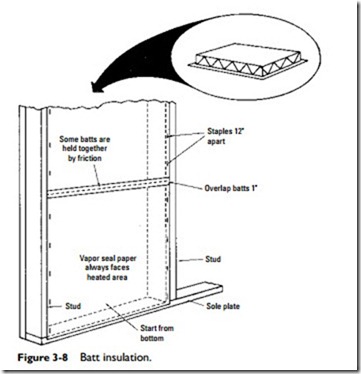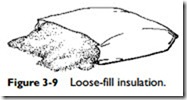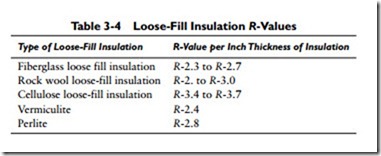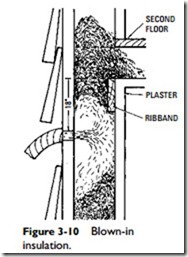Loose-Fill Insulation
Loose-fill insulation (Figure 3-9) is available in granular, fibrous, or powdered form and is sold in bulk, usually in bags (Table 3-4). It is commonly produced from vermiculite, perlite, glass fiber, cellulose, or rock wool. Because loose-fill insulation is so easy to install, it is often used to insulate the cavities between joists in unfinished attics.
Note
A major disadvantage of loose-fill insulation is that it eventu- ally tends to settle and lose some of its effectiveness as an insulating material.
Note
Vermiculite and perlite loose-fill insulation are seldom used today as an insulating material in residential construction.
Blown-in insulation (Figure 3-10) is a loose-fill insulating material, typically fiberglass, rock wool, or cellulose (see Loose-Fill Insulation). The insulation material is blown under pneumatic pressure into the spaces between joists and wall studs in an existing structure. Water vapor retarders are applied first and are available in the form of a moisture-resistant, spray-on paint. Blown-in insulation is most commonly used to insulate interior walls, especially in existing structures. Blown-in insulation also can be used in new construction, but the wall cavities first must be covered with tempoary containment sheeting to hold insulation in place. The insulation is then blown into the wall cavities, and the studs are covered with the appropriate finishing material.
Foam Insulation
Foam insulation is available in spray-in-place systems as well as rigid boards. Spray-in-place foams have very high insulating R-values. For example, spray polyurethane foam has an R– value range of between R-5.6 to R-6.3 per inch of thickness. The spray equipment requires skilled workers to operate. Common spray-in-place foams include
polyurethane foam, urea-formaldehyde (UF) foam, and phenolic foam. These foam insulations expand and set almost immediately after their application. They will eventually shrink and settle in the wall cavities, but their shrinkage should be not more than 5 percent if they are properly applied.
Caution
Foam insulation is flammable and requires a fireproof covering material if it is installed on the interior of a structure.



